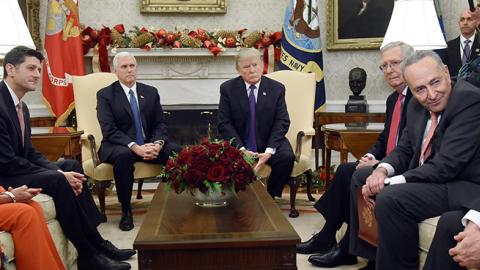Editor’s Note: On December 14, 2017, the American Enterprise Institute installed at its headquarters in Washington, D.C. a bust of its former president, Christopher C. DeMuth, sculpted by artist Chas Fagan. The following is a lightly edited transcript of Mr. DeMuth’s remarks at a dinner celebrating the occasion.
Thank you for having me back to AEI and for commissioning Chas Fagan to create the splendid bust of your former Dear Leader.
The bust is so true to life that it might, like Hermione’s statue in The Winter’s Tale, come to life at any moment — and indeed here I am. So just remember that I’ll be staying and keeping watch over all of you.
But I must say that I am disappointed about one thing: There were no protesters outside, and no one has demanded that my bust be taken down. I feel that my bid for immortality is not yet fully realized.
For me, the greatest pleasure of this honor has been getting to know Chas Fagan, who is an artist of stupendous talent and a man of character and conviction. He tells me that, when I first walked into his studio, I did something no one had done before: Surrounded by his miraculous likenesses of Lincoln, Reagan, both Bushes, Neil Armstrong, and Saints Teresa and John Paul II, I immediately pointed to the corner and said “Hey — there’s David Horowitz!”
I recommend that everyone visit Chas’s website and Google Images and spend some time with his stirring re-creations of American patriots, pioneers, and natives. They ennoble many public spaces and will stand forevermore. Thank you, Chas Fagan.
These days, the American public square is less than noble. It has become angry, polarized, frequently abusive, and sometimes violent. This state of affairs has many cultural, political, and intellectual explanations. At AEI, Michael Barone, Arthur Brooks, Nick Eberstadt, Charles Murray, Christina Hoff Sommers, and others have offered brilliant diagnoses and prescriptions.
Our frenzied public square is not all bad. Since the election of Donald Trump, I have noticed that it is no longer safe to talk politics at Washington dinner parties. Instead, just to keep things civil, we turn in desperation to literature, art, music, poetry — even religion. Best of all, I can entertain everyone with my amazing repertoire of mathematical puzzles.
But the downsides are serious. Key precepts of liberal democracy are coming to seem contingent and perhaps outmoded — due process, the presumption of innocence, freedom of speech. In last year’s presidential campaign, both major candidates called for eliminating First Amendment protections for certain kinds of political speech. Many young people say that speech should be suppressed if it is unsettling to sensitive persons or groups. At a Hudson Institute reception in New York last week, I complimented a woman on her lovely dress, and she replied, “That’s it, buster, you’re finished.” (It was a joke, I think.)
The bitterness of our divisions amounts sometimes to force and violence — in the streets and on the campuses, directed even at AEI eminences. This is itself a rebuke to liberal democracy. Our governing institutions are supposed to resolve matters of public dispute in ways that are accepted as legitimate. The resolutions are typically muddled and compromised. This is said to be necessary for maintaining civil peace in a nation of diverse, often conflicting, interests and values. The justification becomes problematic as civil fury intensifies.
There are times, such as the Civil War, where conflict becomes too intense and implacable for democratic institutions to manage. That is not the case today. We face some divisive problems and some grave ones — immigration, terrorism, nuclear confrontation. But on none of them is the range of public opinion, or the range of available options, so wide as to be unbridgeable. Our political distempers are of a different sort. Many involve questions of manners, dignity, amenity, and sexual relations that until recently were not regarded as questions for government at all.
n my view, an important culprit is high affluence and technology. Americans have attained levels of material comfort, leisure time, and education unknown until the recent past. And our lives are entangled by networks of communication that have become so reticulated and dynamic as to be virtually organic. Even Alex Pollock might agree that this is unprecedented. We have acquired astounding powers and abilities of self-expression and coordinated action.
At one level, we have entered a world of empowered mass intimacy. We know a traffic jam is forming a mile ahead and how to get around it. We know who bought our products this morning, or who cited our publications, and why. But we also know, with equal immediacy, of the wickedness and depravity around us — from social-media harangues to sexual assaults to calculated slaughters of innocents. Mass intimacy encourages both the better and the darker angels of human nature.
At another level, we are now able to organize ourselves into highly defined networks of affinity and endeavor. This is wonderful when we are seeking a compatible mate, a reliable dog-walker, or a promising business partner. More generally, networks are key mechanisms of human accomplishment in science, art, commerce, and learning; their spread is boosting all of these excellent pursuits.
But they are also fracturing our politics. American democracy has long been organized, and stabilized, by institutions — political parties, Congress, federalism, civic associations. These have been deconstructed by a thousand networks of ideology, interest, and identity. AEI saw it coming: Decades ago, Jim Wilson discerned “the atomization of politics,” and Bob Nisbet, “the twilight of authority.” Niall Ferguson’s new book, The Square and the Tower, brings the analysis up to date: The supercharged networks of the modern public square have shaken the towers of public authority to their foundations.
In authoritarian nations such as China and Russia, the towers of authority have struck back with their own networks of surveillance and control. But in democratic nations such as the United States, the private networks have commandeered central institutions of government.
Congress, especially, has been transformed by the arrival of many more numerous political causes than a representative legislature can manage. It has adapted to the extravagant demands of a rich, networked polity through delegation — delegating its lawmaking responsibilities to specialized executive agencies, and its fiscal responsibilities to future generations. Its members have adapted as well. In place of legislative deliberation through committee hierarchies, they strut and fret on the national stage on behalf of partisan and ideological causes, and lobby executive agencies on behalf of narrow interest groups.
The circumstances I have described lead me to a suggestion. It is that we — political and intellectual activists and think tanks — should concern ourselves more explicitly with the healthy functioning of our institutions of government. In recent years, this sort of research and advocacy has largely concerned the work and doctrines of the judiciary; here I am thinking of the Federalist Society, and of Mike Greve’s landmark book, The Upside-Down Constitution, written at AEI. The political branches deserve equal attention.
I am not suggesting that our current work on policy, ideas, and culture has become less important. In a world where the slightest enthusiasm or complaint can penetrate Congress and cause a stir, expounding the principles of limited government and subsidiarity is more urgent than ever. But institutions powerfully influence the course of policy, ideas, and culture. AEI and other think tanks have been working on health-care policy for 30 years. We have produced solid, detailed, thoroughly considered blueprints for reform and promoted them with legislators, candidates, and the public. But when the moment of opportunity arrived this year, good ideas and positively inclined legislative majorities were not enough. This was a monumental institutional failure.
To illustrate the kind of work I have in mind, let me argue for two concrete institutional reforms. First, the Senate should abolish the filibuster and the single-member “hold” on nominations and legislative motions. It should become, like the House, a majority-rule assembly.
As many of you know, what is today called the filibuster is not the one valorized in Mr. Smith Goes to Washington. In olden days, filibustering meant abusing the Senate custom of unlimited floor debate. It was physically taxing and recognized as a desperation move, resorted to only in cases of extreme minority or home-state opposition. In some notable cases, the filibusterers, having demonstrated the depths of their opposition, then freely acceded to the majority vote they knew they were going to lose.
That practice has evolved into a set of rules that permit even a single member — with no speechifying, and often no more effort than sending an email — to move most matters of Senate business from a majority vote of 51 to a supermajority vote of 60. But the rules admit of several exceptions, where a simple majority is now sufficient for votes on judicial nominations, the overruling of recent agency regulations under the Congressional Review Act, and the reconciliation of Senate and House budgets in the course of annual budgeting.
The exceptions have just given us a controlled experiment in the performance of a majority versus a supermajority Senate. The Republicans, in their first year of unified government but with a bare 52-vote Senate majority, achieved important victories under the exceptions. These were the confirmation of Neil Gorsuch to the Supreme Court and several conservative judges to lower courts, and the repeal of 15 Obama-era regulations under the Congressional Review Act. All of these actions were controversial and vigorously contested. All (with the exception of a few judgeships) were decided by fewer than 60 votes. All of them vindicated Republican campaign pledges that had figured prominently in their electoral triumphs. And all were recognized as legitimate, workaday government, even by Resistancers and Never-Trumpers.
But that was it. Where Senate Republicans faced the 60-vote hurdle, as in their efforts to revise inherited 2017 spending priorities, they failed.
Most telling was the strategy of using budget reconciliation to repeal and replace Obamacare by majority vote, in order to overcome the certain opposition of all 48 Democrats. This proved catastrophic to the Republicans’ most important campaign pledge. The budget procedures required them to focus on taxing and spending, and to cede influence over political debate to the bean-counting estimates of the Congressional Budget Office. Many legal and regulatory revisions that are critical to conservative health-care reform were off-limits. This greatly limited the range for bargaining and compromise among different Republican factions.
The differences within Republican ranks were certainly important. But if Republicans had begun by adopting a majority rule for legislation, and proceeded to compose their health-care plan through regular order and committee hearings and advocacy, their prospects of success would have been immensely greater. Given the merits and political appeal of the reforms that AEI, National Affairs, and others had prepared for the fray, I daresay they would have succeeded.
Last April, President Trump called on Senate Republicans to abolish the filibuster for legislation. In response, 61 senators, including majorities of Republicans and Democrats, released a letter rejecting “any effort to curtail the existing rights and prerogatives of Senators to engage in full, robust, and extended debate,” so that “this great American institution continues to serve as the world’s greatest deliberative body.”
This was empty rhetoric. The 60-vote rule has nothing to do with debate and deliberation. Nor is it “ancient,” as President Trump had thought. It is a thoroughly modern innovation for empowering individual senators and small factions to thwart the ordinary legislative process for personal advantage. It is the highest institutional embodiment of today’s atomized, entrepreneurial Congress, whose members are primarily solo activists and self-publicists rather than participants in the process of collective political choice that our system depends on.
Many conservatives and libertarians have a separate reason for wanting to hold to a supermajority Senate: They regard legislative politics as inherently biased toward government growth at the expense of individual liberty and private ordering. In this view, the higher the threshold for legislating, the better. Even if majorities are bound to get their way in the long run, at least we can slow-walk the arc of history that is leading to our doom.
This is a serious argument, not empty rhetoric, but I think it is wrong. Libertarian and conservative sentiments are very strong in American society. Progressivism has become an elite enterprise, dependent on political subterfuge and misdirection as in the passage of Obamacare. The greatest threat to individual liberty is the administrative state, which operates through legislative delegation and manipulation by interest groups. The Congressional Review Act has demonstrated how legislative majorities can un-delegate administrative government, but its range is extremely limited.
Finally, modern electioneering employs sophisticated data analytics and highly tailored communications down to the precinct and household levels. This, in tandem with our two-party system, tends to generate closely divided Congresses. Small majorities need to be able to make good — and bad — on their campaign promises if we are to maintain any kind of political accountability.
My second institutional reform is a balanced-budget amendment to the Constitution. The idea is widely derided. For one thing, it is said to be unworkable, because revenues are contingent and deficits are sometimes desirable or necessary, as in economic downturns and in times of war. But those problems have been solved by Glenn Hubbard and Tim Kane. Their amendment holds each year’s total spending to the median annual revenue of the previous seven years, and permits temporary deficits by supermajority votes.
The deeper objection is that the balanced-budget amendment is an evasion — a means for politicians such as Ronald Reagan to sound fiscally responsible while practicing deficit spending on behalf of their own policy agendas. In this view, the responsible course is to face up to the need for controlling future Social Security, Medicare, and other entitlement deficits through tax increases, benefit reductions, or both, and to brace up Congress’s spineless budgeting procedures.
This objection entirely misses the fiscal dynamics of modern politics. For most of American history — from 1789 through the late 1960s — we did adhere to a balanced-budget rule through broad, bipartisan consensus. Regular government operations were held to a balanced budget; borrowing was limited to wars, other emergencies, and investments such as territorial expansion and transportation; and incurred debts were paid down diligently. The tradition was never refuted or rejected — Keynes himself was a budget balancer over the business cycle. Instead, it was simply overtaken by the transformation of government from a provider of public goods to a provider of private benefits (money and services) directly to individuals.
The basic fiscal history of the past 50 years is the gradual discovery of a political magic formula. It is for the government to provide the electorate with higher levels of immediate benefits than it charges in taxes to pay for those benefits. Voters have come to expect this, and politicians are happy to oblige, leaving the gap to be paid by people who are not voters because they haven’t been born yet. Since the early 1970s, when transfer payments began to dominate federal spending, we have run large deficits practically every year. To be sure, we have also borrowed for military necessities and to get through economic downturns. But our now-gargantuan public debt is largely the result of routine borrowing for current consumption. This is certainly unsustainable and likely to lead to serious grief before long. But it is also a big problem right now. It is corrupting the relationship between citizen and government, and it is leaving us poorly prepared to respond to big emergencies when they arrive, as inevitably they will.
American politics is at is best when responding to big, ambitious, unifying challenges. I conceive of a campaign for a balanced-budget amendment as such a project — focused on public education about the perils of our current practices, and calling for a secular reawakening. The welfare state, properly understood by Friedrich Hayek and others, is an effort to continue in modern conditions the immemorial practice of taking care of those who are poor, disabled, or in distress. This is not like building a highway. It is the responsibility of we the living.
A taxpayer-financed welfare state will be smaller than our current one, and, one hopes, more disciplined and targeted and less prone to abuse. Nevertheless, it will require a far different tax system — much broader and less progressive. Our tax system has become one more device for government dispensation of personal benefits: Tax reform now means distributing tax cuts to politically defined groups, and taking increasing numbers of Americans off the income-tax rolls altogether. Sita Slavov and Alan Viard explained the results in two spectacular 2016 papers. The U.S. tax system is far more progressive than those of other advanced economies, but it is also much smaller — raising considerably less revenue. In contrast, the large welfare states of Europe depend on large, regressive, relatively efficient revenue programs, dominated by the VAT’s flat consumption tax.
Putting contemporary government on a budget would be more than fiscal rectitude. It would mean reenlisting large numbers of middle-income Americans as serious taxpayers with full responsibility for the transfer state. It would mean redefining the role of citizen from benefit collector to, well, to citizen.
The common theme of my two institutional brainstorms is responsibility — that of citizens for their government, and of government officials for our Constitution. I want to use the idea of responsibility to counter the splintering and self-absorption fostered by high affluence and high-tech political organization. And to make our politics more practical and less ideological. The merits of my proposals, and their political feasibility, are certainly contestable, but that is less important than the business of institutional design. How government manages our differences has been an important subject of public debate in many periods of our history. The period we are in seems like a good one for returning to those questions.
Thank you for hearing me out. And thank you, from the bottom of my heart, for the lapidary honor you have done me today.




















